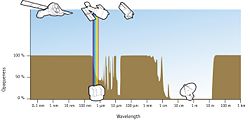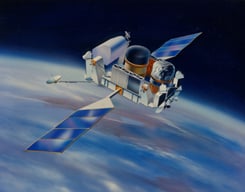Gamma-ray astronomy
Gamma-ray astronomy is a branch of astronomy that deals with the detection and study of gamma rays in the cosmos. Gamma rays are the most energetic form of electromagnetic radiation and are produced by phenomena such as explosions and high-speed collisions. Thus, gamma-ray astronomy provides the opportunity for scientists to study objects and phenomena in the universe that are associated with extremely high energies.
Astronomers have found that the universe contains a uniform background of gamma radiation, which has been attributed to the interaction of cosmic rays with interstellar gas. They have also found gamma rays originating from solar flares. In addition, they have detected immensely powerful gamma-ray bursts (GRBs) that appear to come from sources in deep space. These GRBs last anywhere from fractions of a second to minutes, popping off like cosmic flashbulbs from unexpected directions before fading away. Studied for over 25 years with instruments aboard various satellites and space probes, the sources of these high-energy flashes remain a mystery.
Early history
Long before scientists could detect gamma rays from cosmic sources, they had suspected that the universe may be producing photons in this energy range. Work by Eugene Feenberg and H. Primakoff in 1948, Sachio Hayakawa and I.B. Hutchinson in 1952, and Morrison in 1958, led to the prediction that a number of different phenomena in the cosmos would result in the emission of gamma rays. These phenomena included supernova explosions, interactions of cosmic rays (very energetic charged particles in space) with interstellar gas, and interactions of energetic electrons with magnetic fields.[1]
Most of the gamma rays coming from space are absorbed by the Earth's atmosphere. For this reason, the development of gamma-ray astronomy was delayed until it became possible to place detectors above most (if not all) of the atmosphere, using balloons or spacecraft. In 1961, the Explorer 11 satellite carried the first space-based gamma-ray telescope, which detected less than 100 cosmic gamma-ray photons.[1] As these photons seemed to come from all directions, they suggested the presence of a uniform "gamma-ray background" in the universe. Such a background would be expected from the interaction of cosmic rays with interstellar gas.
In the late 1960s and early 1970s, gamma-ray astronomy received an unexpected boost from a constellation of defense satellites. Detectors aboard the Vela satellite series, designed to detect flashes of gamma rays from nuclear bomb blasts, began to record bursts of gamma rays not from the vicinity of the Earth but from deep space.
The first true astrophysical gamma-ray sources detected were solar flares, which revealed the strong 2.223 MeV line predicted by Morrison. This line results from the formation of deuterium via the union of a neutron and proton; in a solar flare the neutrons appear as secondaries from interactions of high-energy ions accelerated in the flare process. These first gamma-ray line observations were from the spacecrafts OSO-3, OSO-7, and the Solar Maximum Mission, the last of which was launched in 1980. The solar observations inspired theoretical work by Reuven Ramaty and others.
Significant gamma-ray emission from our galaxy was first detected in 1967 by the gamma-ray detector aboard the OSO-3 satellite. It detected 621 events attributable to cosmic gamma rays.
The field of gamma-ray astronomy took great leaps forward with the SAS-2 (1972) and the COS-B (1975-1982) satellites. These two satellites provided an exciting view into the high-energy universe. They confirmed the earlier findings of the gamma-ray background, produced the first detailed map of the sky at gamma-ray wavelengths, and detected a number of point sources. However, the poor resolution of the instruments made it impossible to identify most of these point sources with individual stars or stellar systems.
Recent observations
During its High Energy Astronomy Observatory program in 1977, NASA announced plans to build a "great observatory" for gamma-ray astronomy. The Compton Gamma-Ray Observatory (CGRO) was designed to take advantage of the major advances in detector technology during the 1980s, and it was launched in 1991. The satellite carried four major instruments which have greatly improved the spatial and temporal resolution of gamma-ray observations. CGRO provided large amounts of data, which are being used to improve understanding of the high-energy processes in the universe. CGRO was deorbited in June 2000 because of the failure of one of its stabilizing gyroscopes.
BeppoSAX was launched in 1996 and deorbited in 2003. It predominantly studied X-rays, but also observed gamma-ray bursts. By identifying the first non-gamma ray counterparts to gamma-ray bursts, it opened the way for precise determination of their positions and optical observation of their fading remnants in distant galaxies.
The High Energy Transient Explorer 2 (HETE-2)[2] was launched in October 2000 (on a nominally 2-year mission) and was still operational in March 2007. Swift, a NASA spacecraft, was launched in 2004 and carries the BAT instrument for gamma-ray burst observations. Following BeppoSAX and HETE-2, it has observed numerous X-ray and optical counterparts to bursts, leading to distance determinations and detailed optical follow-up. These have established that most bursts originate in the explosions of massive stars (supernovas and hypernovas) in distant galaxies.
Currently, the main space-based gamma-ray observatories are the INTErnational Gamma-Ray Astrophysics Laboratory, (INTEGRAL), and the Gamma-ray Large Area Space Telescope (GLAST). INTEGRAL is an ESA mission with additional contributions from Czech, Poland, U.S., and Russia. It was launched on October 17, 2002. NASA launched GLAST on 11 June 2008. It includes LAT, the Large Area Telescope, and GBM, the GLAST Burst Monitor, for studying gamma-ray bursts.
Very energetic gamma rays, with photon energies higher than about 30 GeV, can also be detected by ground-based experiments. The extremely low photon fluxes at such high energies require detector effective areas that are too large for current space-based instruments. Fortunately, such high-energy photons produce extensive showers of secondary particles in the atmosphere that can be observed on the ground, both directly by radiation counters and optically via the Cherenkov light the ultra-relativistic shower particles emit. The Imaging Atmospheric Cherenkov Telescope technique currently achieves the highest sensitivity.
The Crab Nebula, a steady source of so-called TeV gamma-rays, was first detected in 1989 by the Whipple Observatory at Mt. Hopkins, in Arizona in the USA. Modern Cherenkov telescope experiments like H.E.S.S., VERITAS, MAGIC, and CANGAROO III can detect the Crab Nebula in a few minutes.
The most energetic photons (up to 16 TeV) observed from an extragalactic object originate from the blazar Markarian 501 (Mrk 501). These measurements were done by the High-Energy-Gamma-Ray Astronomy (HEGRA) air Cherenkov telescopes.
Gamma-ray astronomy observations are still limited by non-gamma-ray backgrounds at lower energies, and, at higher energy, by the number of photons that can be detected. Larger area detectors and better background suppression are essential for progress in the field.
See also
- Astronomy
- Black hole
- Electromagnetic spectrum
- Gamma ray
- Gamma ray burst
- Neutron star
- Photon
- Supernova
- X-ray
- X-ray astronomy
Notes
- ↑ 1.0 1.1 NASA, The History of Gamma-ray Astronomy. Retrieved February 18, 2009.
- ↑ NASA, The HETE-2 Satellite. Retrieved February 19, 2009.
ReferencesISBN links support NWE through referral fees
- Aharonian, Felix A. Very High Energy Cosmic Gamma Radiation: A Crucial Window on the Extreme Universe. Singapore: World Scientific, 2004. ISBN 9810245734.
- O'Dell, Stephen L., and Giovanni Pareschi (eds.). Optics for EUV, X-Ray, and Gamma-Ray Astronomy III. Bellingham, WA: SPIE, 2007.
- Ramana Murthy, P. V., and A. W. Wolfendale. Gamma-Ray Astronomy. Cambridge Astrophysics Series, 22. Cambridge, UK: Cambridge University Press, 1993. ISBN 0521420814.
- Weekes, Trevor C. Very High Energy Gamma-Ray Astronomy. Series in Astronomy and Astrophysics. Bristol: CRC Press, 2003. ISBN 0750306580.
External links
All links retrieved April 17, 2024.
- The Swift Gamma-Ray Burst Mission. NASA.
- The HETE-2 Satellite. NASA.
- Exploring the non-thermal Universe . The HEGRA Atmospheric Cherenkov Telescope System, Max-Planck-Institut für Kernphysik.
- High Energy Stereoscopic System (H.E.S.S.). (Ground-based observatory studying very high energy (VHE) gamma-ray astrophysics.)
- Gamma-ray astronomy at low energies with high sensitivity. The MAGIC Telescope.
- INTEGRAL Latest News. (The space-borne INTEGRAL observatory.)
Credits
New World Encyclopedia writers and editors rewrote and completed the Wikipedia article in accordance with New World Encyclopedia standards. This article abides by terms of the Creative Commons CC-by-sa 3.0 License (CC-by-sa), which may be used and disseminated with proper attribution. Credit is due under the terms of this license that can reference both the New World Encyclopedia contributors and the selfless volunteer contributors of the Wikimedia Foundation. To cite this article click here for a list of acceptable citing formats.The history of earlier contributions by wikipedians is accessible to researchers here:
The history of this article since it was imported to New World Encyclopedia:
Note: Some restrictions may apply to use of individual images which are separately licensed.

